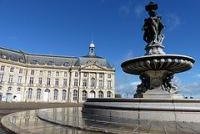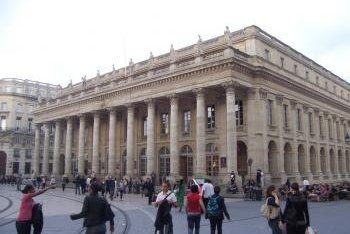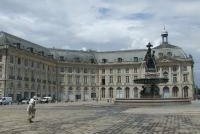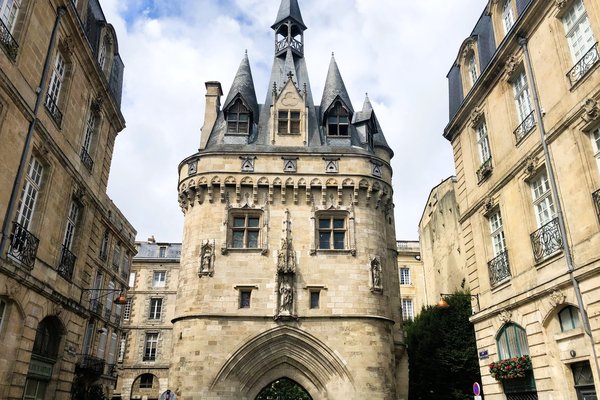France
Bordeaux
Bordeaux, Port of the Moon, is an outstanding urban and architectural ensemble created in the Age of Enlightenment.
A bend in the river Garonne has created a natural harbour here, and because of its shape, it's called Port of the Moon. The site encompasses the historic centre of Bordeaux, known for its wine production and commercial port. Its urban transformation from the 1730s onwards had a focus on neoclassical architecture.
Community Perspective: Bordeaux is a fine city to visit, with its riverside setting and it all looks neat and well-preserved. It has some lovely buildings though none stand out.
Site Info
Official Information
- Full Name
- Bordeaux, Port of the Moon (ID: 1256)
- Country
- France
- Status
-
Inscribed 2007
Site history
History of Bordeaux
- 2008: Reinforced Monitoring
- Destruction of the Pertuis Bridge
- 2007: Inscribed
- Inscribed
- Type
- Cultural
- Criteria
- ii
- iv
Links
- UNESCO
- whc.unesco.org
- Official
-
- bordeaux-tourisme.com — Bordeaux Tourisme
All Links
UNESCO.org
- whc.unesco.org — whc.unesco.org/
Official Website
- bordeaux-tourisme.com — Bordeaux Tourisme
Community Information
- Community Category
- Urban landscape: Post-medieval European
Travel Information
Exact locations inscribed twice (or more)
Recent Connections
-
Over 100,000 inhabitants
Population: 139,399 inhabitants in the …
-
Botanical Gardens
Part of the Jardin Public -
Aquitania hotspot
Connections of Bordeaux
- Individual People
-
-
Visited by Alexander von Humboldt on his travels
Aug 3 1804 - arrived by sea -
Napoleon was here
On a visit to Bordeaux in 1808, Napoleon I noted the damage suffered by the cathedral during the Revolution and ordered its restoration.See fr.wikipedia.org
-
Charlemagne
Basilica of Saint Severinus: a legend surrounding the basilica is that the olifant of Roland, nephew of Charlemagne, famous for his death at Roncevaux, was placed on the altar of the Saint-Seurin basilica by the emperor bringing back the body of the valiant knight. The famous Song of Roland also refers to it.See fr.wikipedia.org
-
- Trivia
-
-
Over 100,000 inhabitants
Population: 139,399 inhabitants in the inscribed area. (Source : nomination file, p261). (numbers of 2006, have risen since)
-
Michelin-starred restaurants in Monuments
L'Observatoire du Gabriel ** and La Table d'Hôtes - Le Quatrième Mur *
-
- History
-
-
Second World War
From 1941 to 1943, the Italian Royal Navy established BETASOM, a submarine base, at Bordeaux. Italian submarines participated in the Battle of the Atlantic from that base, which was also a major base for German U-boats as headquarters of 12th U-boat Flotilla. The massive, reinforced concrete U-boat pens have proved impractical to demolish and are now partly used as a cultural center for exhibitions.See en.wikipedia.org
-
Ancient Roman colonies
Bordeaux (Burdigala) : Palais Gallien -
Contains significant structures from the 20th Century
MériadeckSee www.docomomo.fr
-
Popes
Pope Clement V (ca. 1264-1314) was canon and sacristan of the Cathedral of Saint-André in Bordeaux, bishop of Comminges and later Archbishop of Bordeaux. As pope, he "directed numerous donations and concessions to the cathedral" of Bordeaux.See en.wikipedia.org
-
- Ecology
-
-
Tidal effects
Garonne's tidal bore (un mascaret)
-
- Architecture
-
-
Art Deco
Bourse du travail de BordeauxSee fr.wikipedia.org
-
Romanesque
Church of Holy Cross -
Reinforced Concrete
Mériadeck -
Neoclassical architecture
Bordeaux is exceptional in the unity of its urban and architectural classical and neo-classical expression (OUV) -
English garden
Jardin Public: "Under Napoleon III the gardens were transformed into a traditional English formal garden, and extended. This is the present form of the gardens." -
Designed by Gustave Eiffel
Garonne River Bridge -
Gothic Revival
Bordeaux Cathedral: "A prominent feature of the south side is the row of buildings with neo-Gothic facades called the New Sacristies, which are placed against the south wall between the buttresses. (...) These were constructed in 1869 and 1879 by the 19th-century architect Paul Abadie in the place of the medieval cloister."See en.wikipedia.org
-
Renaissance
Bordeaux Cathedral: "(...) the north walls of [the north side of the nave] of the cathedral have had a history of stability problems, and have required the construction of additional flying buttresses over the years. The largest of these, called the Gramont buttress (...), was begun in 1531 and is a monument in itself. It has the flying arches of a Gothic buttress, but is covered with (...) lavish Renaissance decoration, including a host of small putti, or angels, and carved inscriptions describing the Biblical Day of Judgement."See en.wikipedia.org
-
- Damaged
-
-
Destroyed or damaged by Earthquake
On February 2, 1427, the Cathedral of Saint-André was damaged by an earthquake that caused part of the vaults to collapse.See fr.wikipedia.org
-
'Threatened' by bridges
-
Damaged in World War II
A bombing in 1940 damaged the Basilica of St. Michael in Bordeaux and destroyed a large part of the stained glass windows. (Routes of Santiago de Compostela in France Nomination file) -
Iconoclasm
Bordeaux Cathedral: "During the French Revolution, the furniture and much of the decoration of the cathedral was removed or vandalised." "The sculpture of the tympanum of the royal portal was made in between 1200 and 1250 and is considered some of the oldest and best of the cathedral. It was spared destruction because the portal at the time of the Revolution was hidden by other structures."See en.wikipedia.org
-
Cultural sites damaged by fire since inscription
Basilica of Saint Severinus: The sacristy was damaged by a fire on 13 June 2018.
-
- World Heritage Process
-
-
Exact locations inscribed twice (or more)
Elements are also part of 'Routes of Santiago de Compostela in France' -
Perfect Inscriptions
2007
-
- Religion and Belief
-
-
Cathedrals
Cath Saint-Andre, Cath SJ-Baptitste - Former Cath -
Religious Relics
The crypt of the Basilica of Saint Severinus houses the sarcophagi of the saints Severinus, Delphin, Amandus of Bordeaux, Veronica and Bénédicte.See fr.wikipedia.org
-
- Human Activity
-
-
Tramways
-
Slavery
18th century slave trade -
Sea Ports
-
Sugar
18th century sugar trade -
Invention of sweets and pastries
Canelé, "a small French pastry flavored with rum and vanilla with a soft and tender custard center and a dark, thick caramelized crust". The canelé is believed to originate from the Couvent des Annonciades, Bordeaux in either the 15th or the 18th century. (wiki)See en.wikipedia.org
-
Forced labour during WWII
Base sous-marine de BordeauxSee fr.wikipedia.org
-
- Constructions
-
-
Freestanding Bell Tower
Tour Pey-Berland, campanile of Bordeaux Cathedral -
19th century shopping arcades
Galerie Bordelaise and Passage Sarget, both opened in 1834See fr.wikipedia.org
-
Cenotaph
The crypt of the Basilica of Saint Severinus houses the cenotaph of Saint Fort.See fr.wikipedia.org
-
Monumental Fountains
At the foot of the Girondists monument -
Notable Bridges
Pont de Pierre (1822), a stone bridge in French Classical style and with nineteen arches, more than 500m long.See en.wikipedia.org
-
Large squares
Place des Quinconce, 126000 m2 -
Unfinished constructions
Bordeaux Cathedral: "The south front of the transept is flanked by two towers which were built to contain the Cathedrals' bells. They were originally intended to have spires, which were never built."See en.wikipedia.org
-
Railways
Gare Saint Jean and its Rail Bridge designed by Gustav Eiffel -
Roman amphitheatres
"antique amphitheatre, the Palais Gallien (Gallien Palace)" (AB)
-
- WHS on Other Lists
-
-
European Route of Historic Theatres
French Route: Grand-ThéâtreSee www.erht.eu
-
Pritzker Architecture Prize
Richard Rogers (winner 2007): Extension of the Palais de JusticeSee fr.wikipedia.org
-
- Timeline
-
-
Built in the 18th century
Major monuments date from the 1730s onwards
-
- WHS Hotspots
- Science and Technology
-
-
Botanical Gardens
Part of the Jardin Public
-
News
No news.
Recent Visitors
Visitors of Bordeaux
- Alberto Rodriguez Gutierrez
- alex
- Alexander Barabanov
- Alexander Lehmann
- alicemears
- Alikander99
- Ali Zingstra
- Alvaro1404
- A. Mehmet Haksever
- Ammon Watkins
- Ana Lozano
- AndreaTLV
- Angela Vandyck
- Anna Wludarska
- Antonio J.
- Argo
- ArnaudFilloux
- Artur Anuszewski
- Aspasia
- Atila Ege
- AustralLights
- Bauchat
- BaziFettehenne
- BenReeve
- Bill Maurmann
- Bin
- BobSmithseestheworld
- bossc
- Bruno_Pires
- CampbellME
- Caspar
- Catoplayer
- CeeMon
- Cezar Grozavu
- chenboada
- Cheryl
- CherylKla
- Christian Wagner
- Christine
- Chunsian01
- Cirene Moraes
- Claire Bradshaw
- ClaraHH
- Clyde
- Col
- Crinion
- Cristina Erba
- Csaba Nováczky
- CugelVance
- Cyberczar
- Damientournay
- Dani Cyr
- Daniela Hohmann
- Daniel Chazad
- Daniel Gabi
- Daniel R-F
- Dan Pettigrew
- David Berlanda
- Delphine Delaunay
- Dennis Nicklaus
- Dimitar Krastev
- DjhMck
- Don Irwin
- DouglasR
- DutchHorn
- Dwight Zehuan Xiao
- Echwel
- Elaine McArdle
- Elia Vettorato
- Ellen Nielsen
- Els Slots
- Erfe91
- Erik Jelinek
- Eva Kisgyorgy
- fabi-ddorf
- Fan Yibo
- Farinelli
- Fede1203
- Feldhase
- Femke Roos
- Filip Murlak
- Frederik Dawson
- frizzle
- Garry Jackson
- George Gdanski
- GeorgeIng61
- GerhardM
- Gernot
- giloudepuertorico
- giulio25
- grimloch
- Grzegorz Andruszkiewicz
- Harald T.
- Harry Mitsidis
- Hasco
- H Beswick
- Hdhuntphotography
- Hubert
- Iain Jackson
- Ian Cade
- ih0000
- Ingemar Eriksson
- Ivan Rucek
- Jaakkotoivanen
- Jacob Otten
- Jakob F.
- James F
- Jana and Matt
- janem
- Janos
- Jan-Willem
- Jarek Pokrzywnicki
- Jarrod_Byham
- Jasam
- Jean Lecaillon
- Jeanne OGrady
- Jens
- Jezza
- Joel on the Road
- Jonas Kremer
- Jonas Martinsson
- jonathanfr
- Jonoprout
- jonstst
- Joyce van Soest
- JR's HERITAGE SITES
- Judit Andrea Juhász
- KarenBMoore
- Karito Vies
- KeithBailey
- Ken DJ
- Kerékgyártó
- Kevin247
- Kjlauer
- Klaus Freisinger
- Knut
- KoenigMarke
- Krijn
- krtek
- Laetitia Yin
- Lara Adler
- Lars Bogstad
- Laurine
- LaVale
- Lazerway
- Liamps91
- Loic Pedras
- Luboang
- Lucas Del Puppo
- Ludvan
- Luis Filipe Gaspar
- lynnz317@aol.com
- Maciej Gil
- Małgosia Łupicka
- Manuelfunk
- marc Rouserez
- Marinemajor
- Martinacurra88
- Martina Rúčková
- Marty
- Mathijs
- Matthewsharris
- Max
- MaxHeAnouBen
- MaYumin
- MH
- M. Huineman
- michaelsballard
- Michael Turtle
- Mikko
- Milan Jirasek
- Monica Tasciotti
- montgomw
- MoPython
- Morodhi
- nan
- napalm
- Nasebaer
- Niall Sclater
- Nick M
- Nihal Ege
- nikolamus
- Nikolay Marinov
- opperpco3
- Pat Martin
- Patrik
- Paul Schofield
- Persian Globetrotter
- PeterA
- PeterH
- Peter Lööv
- Philipp Leu
- Philipp Peterer
- Pierre T
- Pieter Dijkshoorn
- Pink Bunny
- Piotr Wasil
- Potsdamer
- Priyaranjan Mohapatra
- Qin Xie
- Rafabram
- Rafał Kałczuga
- Rahelka
- RainbowMarbles
- Randi Thomsen
- reddargon
- Reza
- RJPTravel
- Rodinia
- Roel Sterken
- Roger Ourset
- Roman Bruehwiler
- Rubbie
- Sabrina Liebehentschel
- Sandmann15
- Sandra!
- saraleonela
- Schnitzel
- Sclowitz
- scubarrie
- Sergio Arjona
- Shandos Cleaver
- Shijie ZHU
- sibariam
- SirLoydd
- Slavi
- Solivagant
- Stanislaw Warwas
- Stefan A. Michelfeit
- stephanvermeulen
- Stijn
- streliorsi
- Svein Elias
- Szabolcs Mosonyi
- Szucs Tamas
- Tammy Gouldstone
- Taotao Chen
- Thomas Buechler
- Thomas van der Walt
- Tim Allen
- TimPick
- Tinamu
- Traveling Girl
- triath
- Truls Brekke
- Tsunami
- Vanessa Buechler
- Van Hung
- voyager
- Walter
- WILLIAM RICH
- Wimmy
- Wojciech Fedoruk
- Wo_ko
- wrung24
- Xander Huang
- Xiquinho Silva
- Yi Han Goh
- ZCTLife
- Zhenjun Liu
- Zoë Sheng
- Александар Стојиљковић
Community Reviews
Show full reviews
While the Basilica of St. Michael might be the most notable monument of Bordeaux, the most memorable part of our stay was an excellent bicycle tour that we took. On our own, we probably wouldn't have dared attempting bike riding in the center of such a big city, but the guide knew the perfect route on lesser-used streets and bike paths. Walking around on our own, we had seen the basilica and some other grand monuments, but the bike tour took us to some other interesting parts, such as the ruins of the roman amphitheater and the unconventional Darwin shopping hall across the river from the main downtown area. Near the Gross Cloche, our bike tour guide also introduced us to the local cannelés and explained the connection between the pastry and the french colonial era, represented by the rum, vanilla, and spices in the cakes. The Jardin Public near downtown was also a highlight, and though it isn't a distinguishing WHS feature, it is a beautiful aspect of the city.
October was a wonderful time of year to visit this pleasant city, and enjoy its pastry shops and cafes. We stayed the opposite direction from downtown from the train station, so we got to walk through some other neighborhoods and enjoyed sampling some dishes at the Halle Boca food court.
Keep reading 0 comments
When our car crossed Pont de Pierre and we saw the whole skyline with the long row of stately buildings along the Garronne and Porte de Bourgogne at the end of the bridge was like a symbolic city gate, Bordeaux welcomed us with its really grand appearance. This was my second time I visited Bordeaux, but last time I travel by train and did not have a chance to see this fantastic view. After hotel check in, we drove our car to see the city, the traffic was really bad as there were many junctions, and the new tram system also added more traffic lights. Bordeaux’s city center was like little Latin Quartier of Paris with many fine buildings, nice but nothing remarkable.
In my opinion the only part of the city that made Bordeaux stunning is the riverside, all the beaux art buildings seem to be transported from Paris grand boulevards of Baron Haussmann. The crescent shape of the riverside made the whole view of these buildings more magnificent and looked endless. We decided to park our car near Place des Quinconces that unfortunately closed for preparation of city festival. We walked to see the famous Place de la Bourse, the square was indeed very grand and the best sight of Bordeaux. The riverside terrace was a popular place for evening exercise, I saw many joggers, cyclists and many safety patrols. Flèche Saint-Michel, the gothic tower of Basilica of Saint Michael was a landmark dominating the southern part …
Keep reading 0 comments
I visited Bordeaux in March 2014. The view of the Port while strolling on the Pont de Pierre is already something to behold. Numerous spires, steeples and elegant buildings adorn the waterfront of the Garonne river. Place de la Bourse is magnificent - the epitome of symmetry and beauty. Not only is it a wonderful sight, effortlessly accessible with the modern Bordeaux trams, but it is in a way enhanced with a touch of innovative genius. Just opposite, every now and then, the open space of the wide waterfront transforms itself first into a flooded space or giant puddle, then in an enormous mirror which depicts a surreal reflection of Place de la Bourse and then a spray fountain which slowly but surely fades away into thin air. It's not the only square to visit though - Place des Quinconces, Place Gambetta, Place de Bourgogne, Place de la Comedie, Place Jean Moulin, etc. Bordeaux is one of those cities in France that enjoy double inscription in the Unesco WH list. The Routes of Santiago de Compostela in France WHS includes Cathedral of St. Andrew, the Basilica of St. Michel and the Basilica of St. Seurin. Inside the latter, peregrinos can write their names and prayers on a peregrino guestbook inside one of the minor chapels inside the basilica. For 5,50 euros I climbed the 231 stairs of the Pey-Berland Tower and from the top I could afford incredible panoramic views of Bordeaux and a bird's eye view of the Cathedral. …
Keep reading 0 comments
As the other reviewers have pointed out, Bordeaux is a very pleasant city with many fine monuments and sights, and it is certainly a good base for exploring the many attractions in the surrounding area. There are several historic buildings, a large number of churches, and a fine riverfront to be explored. Even though there are no standout sights (except maybe the Monument aux Girondins at the Place des Quinconces), Bordeaux has a well-maintained centre stretching along a bend of the Garonne River (somewhat shaped like a crescent, hence the name "Port of the Moon"). The massive Cathedral of St. André, as well as the basilicas of St. Michel and St. Seurin, are also part of the Route of Santiago inscription.
Keep reading 0 comments
There's no doubt that Bordeaux is a very pleasant and liveable city. We arrived late in the evening (11 p.m.) and our taxi driver proudly pointed out all the monumental highlights: the bridge across the Garonne, the Place de la Bourse, the old city gates and the water mirror to name but a few. They are all flooded in light after it gets dark: a very fine sight.
The next morning we did a self-guided tour of the main city area, which is not very large. The streets are well-geared to pedestrians, and everything looks very neat and well-preserved. The buildings are very uniform in style and colour. We were already completely in awe of the monumental fountain with its statues of horses at the Place de Quinconces.
As other reviewers have remarked, there are no really outstanding buildings that warrant a separate visit. The most interesting structure may be the Cathedral. This is part of the French Routes to Santiago de Compostela also, and I think that it fits that label better because of its age.
There are lots of smaller things to see and do however in the streets of Bordeaux: the pastry shops, the plentiful terraces of its bars and restaurants, the well-stocked shops (I bought some smelly cheese to take home with me!), the Jardin Public. Combined with especially sunny and warm weather for early October, we had a good time in Bordeaux.
Keep reading 0 comments
I found Bordeaux to be a great, medium sized European city, though it has some lovely buildings there are no real stand out monuments. The large uniform buildings do not seem to be over-powering and the streets are reasonably sized so it doesn't feel intimidating like Paris sometimes can. For me one of the real joys of travelling in Europe is losing time in great cities like this, they do not have the masses of tourists like the continents star attractions but still showcase the architecture and lifestyle that make this such an interesting part of the world to travel in.
My first view of the city centre was the broad sweep of buildings facing the river, from here it is easy to understand the moon shaped layout of the city centre. Perhaps my highlight was strolling aimlessly along St Catherine Street watching everyone else doing pretty much the same. I also enjoyed a lovely wine-tasting session, allowing me to sample the region's most famous export. I would like to suggest this was a cultural quest to get myself better acquainted with the product that led to the development of such a grand port, however I would be lying, it was just because there are few things like more than relaxing with a glass of wine, a newspaper and a plate of cheese in a foreign city.
Bordeaux also deserves top marks for the way in which it has presented its city centre. Obviously a lot of time and money …
Keep reading 0 comments
To get around the large city area I invested 4.10 euros in a day ticket for the trams and buses. During the course of the day I visited the three sites duplicated on the WHS Way of St James, the St Andre cathedral, St Seurin basilica and St Michaels church, as well as some Port of the Moon sites:
Palais Rohan - now the Hotel de Ville
Palais Gallieni - a Roman ruin
Portes de Bourgogne, Dijeaux and Aquitaine - triumphal arches, former city gates
Place Gambetta - a landscaped garden
Place Quinconces - a huge space with an elaborate fountain
Place de la Bourse - elegant customs buildings
Grand Theatre - an elegant colonnaded building
Keep reading 0 comments
